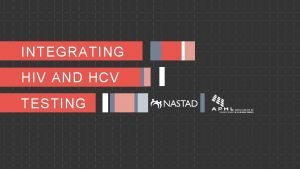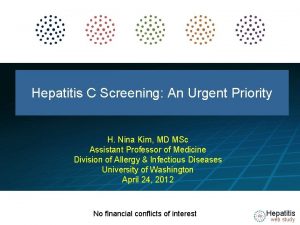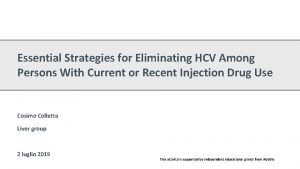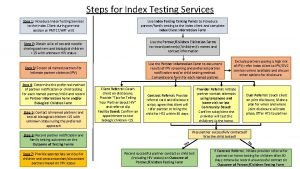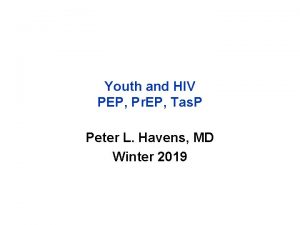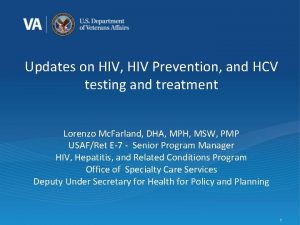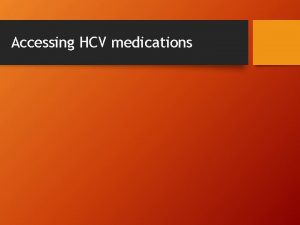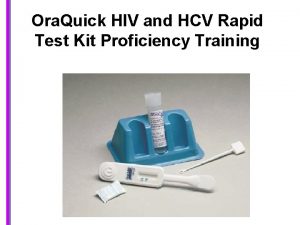INTEGRATING HIV AND HCV TESTING HIV TEST PERFORMANCE







- Slides: 7

INTEGRATING HIV AND HCV TESTING

HIV TEST PERFORMANCE FIGURE 1: LABORATORY MARKERS OF HIV INFECTION HIV RNA (plasma) HIV Antibody HIV p 24 Ag Ig. M Ig. G 0 10 20 30 40 50 60 70 Days Since Infection Figure adapted from Delaney et al. , CID 2017: 64 and provided by M. Owen, NCHHSTP, CDC. 80 90 100

HIV TEST PERFORMANCE HIV TESTS: MEDIAN WINDOW PERIOD IN DAYS BASED ON PLASMA Laboratory-Based Tests POC Rapid Tests Ag/Ab 17. 8 19. 2 Ig. M/Ig. G 23. 1 29. 3 Ig. G 30. 6 31. 1 Test sensitivity is highest when used with plasma and serum samples. Test sensitivity is lower with whole blood. Test sensitivity is lowest when used on oral fluid.

HCV TEST PERFORMANCE FIGURE 2: LABORATORY MARKERS OF HCV INFECTION HCV RNA Anti-HCV core Ag Window Phase 0 10 20 30 40 Days Since Infection Figure provided by S. Kamili, DVH, CDC. 50 60 70 80 90 100 days

TESTING STRATEGIES Laboratory-Based Testing Point-of-Care Rapid Testing Specimen sent to laboratory for testing Testing where client receives services Sequence of tests performed Various supplemental testing methods Laboratory Testing for the Diagnosis of HIV Infection Testing for HCV Infection: An Update of Guidance for Clinicians and Laboratorians Earlier detection than possible with POC

COMPARISON OF TESTING STRATEGIES Laboratory-Based Testing (using CDC-recommended serum/plasma algorithms) Comparison Categories Window period Detect acute infection Point-of-Care Rapid Testing (using CLIA-waived tests) HIV HCV 2 -3 weeks 8– 11 weeks 3 -5 weeks 8– 11 weeks Yes No Yes Final results From a single specimen Negative results from single specimen; Positive results second specimen Testing for multiple infections Yes, multiple tests may be performed on single specimen No, additional specimens needed for other tests Timeframe for delivering results Several hours to days to final Negative results delivered same visit/day. Positive results, several hours to days to final FDA-approved specimen types Serum or plasma Whole blood, serum, or oral mucosal transudate (HIV only) Specimen collection Venipuncture Varies by test (venipuncture, finger stick, or oral fluid). Quality assurance Limited QA assurance by providers. Extensive QA by testing providers

SELECTING A TESTING STRATEGY Population-Level Factors Client-Level Factors Program-Level Factors • HIV and HCV Prevalence • Likelihood of acute HIV infection • Staff capabilities to conduct testing • HIV and HCV Incidence • Likelihood of current HCV infection • HIV-2 prevalence • Likelihood that clients will return for results/linkage • Understanding of the accuracy tests • Staff perceptions and attitudes about strategy • Co-morbidity of HIV and HCV, and/ or with other conditions such as STDs and hepatitis B virus (HBV) • Acceptability of the testing strategy • Appropriateness and relevance to client needs • Cost to client for testing and treatment • Readiness to engage in treatment • Access to treatment • Feasibility of introducing strategy into existing workflow • Laboratory capacity to implement required tests, including CDCrecommended testing algorithms • Delivery of related prevention and treatment services such as HIV Pr. EP



